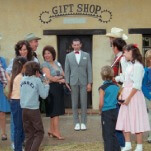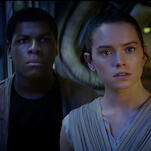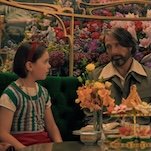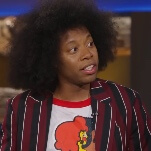The space and streaming races come to a head with For All Mankind and Apple TV+
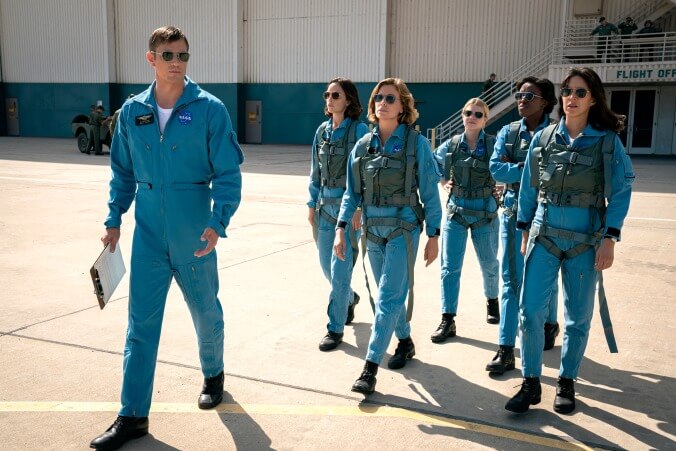
Premiering November 1 on Apple TV+, Ronald D. Moore’s For All Mankind is poised to be an antidote to the bleak alternate realities of series like The Handmaid’s Tale, The Man In The High Castle, HBO’s possibly defunct Confederate, and of course, the dystopia in the making that is our current political landscape. The series, which will be available on the launch day for TV+, drastically reimagines the past, with its vision of the U.S. space program playing catch-up to its Russian counterpart. When season one begins, the lunar plaque is collecting dust at the Kennedy Space Center instead of heralding the arrival of NASA astronauts on the moon “for all mankind.”
Being thwarted in space exploration is an undeniable setback, but Moore, whose Battlestar Galactica reboot serves as a testament to humanity’s resilience, doesn’t use that pivotal moment as carte blanche to subject his characters to misery and suffering. Instead, Moore and his For All Mankind co-creators, Ben Nedivi and Matt Wolpert, envision the loss in 1969 as “just the beginning of an aspirational story that sees the American space program remain a priority and continue to spur the imaginations, hopes, and dreams of a nation.” The show and its executive producers, including Star Trek and BSG vet Maril Davis, are unabashedly optimistic about everything from venturing further into the galaxy to this country’s ability to rally around common goals to For All Mankind’s chances at capturing viewer imagination in an ever-crowded programming landscape.
When I visited the For All Mankind set in February of this year, Moore et al. looked like they had every right to be confident about the show’s odds, even as details of production—and the larger streaming service—were predictably shrouded in secrecy. At the time, Apple was still a month out from a big keynote address about its Apple TV+ service, which, despite being perceived early on in the press as a possible Netflix slayer, was presented as more of what TV editor Erik Adams (who attended the event) called “a Silicon Valley spin on a skinny bundle.” Back in February, the journalists on site, including myself, didn’t yet know the name of the service or what it would cost or when it would premiere. The lure of a new Ronald D. Moore show proved strong enough, which is probably what Apple was counting on. Journalists received press notes just hours before touring the set and conducting interviews with the cast, including Joel Kinnaman, Shantel VanSanten, Jodi Balfour, and Wrenn Schmidt. Little strips of plastic were placed over the cameras on our smartphones, and we were assured that we wouldn’t need to rely on handheld audio recorders because the three- to five-minute interviews would be on camera, and the footage would be sent to us closer to the premiere.
The camera thing wasn’t unusual, as candid photos are almost always forbidden on set visits. Relying on third-party recordings for your interviews kind of was, though; how could we be sure that Apple would turn over unedited footage for use in features like these? (Thankfully, it did.) It was, as Moore noted at a panel that February morning, the first such event for Apple, though you wouldn’t know it from the personal escorts (who came straight from the Genius Bar/Apple store floor) assigned to all reporters. That’s also not an entirely uncommon practice, but it certainly created an even more controlled environment for a set visit, which was a little disorienting after the secrecy and sudden flood of information.
Set visits often have a roulette aspect to them—even when you’re dropping by a show you’ve covered for years, you never really know what you’re going to get out of the round-robin interviews or discussions with production and costume designers. With its escorts, amenities (beverage service at every interview setup), and precise scheduling, Apple was effectively offering concierge service at what would have otherwise been a standard press event. The media conglomerate was, intuitively enough, determined to make a great first impression. And the early afternoon went like clockwork—it had to, because a second group of reporters was set to arrive not long after my group wrapped.
There’s nothing wrong with being organized, but the efficiency and clarity of vision on display that day stands in contrast to the rollout for the Apple TV+ service. Obviously, the latter is a much grander endeavor, with many more moving parts, including multiple series premieres at launch. In addition to For All Mankind, TV+ subscribers will have access to the Jason Momoa-led series, See; the unmitigated pep of The Morning Show duo Reese Witherspoon and Jennifer Aniston; and a YA take on Emily Dickinson in Dickinson on November 1. That’s in addition to kids series Helpsters and Snoopy In Space, as well as the latest iteration of Oprah’s Book Club. But the company initially glossed over much of this crucial info (as well as timing and pricing) at an event last spring, before finally and properly pulling back the curtain at a conference last month.
It’s not that the lead-up to the full announcements was botched, exactly—you’d be hard-pressed to look at the lineup of concepts and talent and conclude that Apple, which has upped its original programming budget to $6 billion, doesn’t know what it’s doing. One of its biggest plays is For All Mankind, which marks Moore’s return to space/sci-fi dramas—though he was quick to clarify that the alternate history is the most sci-fi element early on in the show— and promises the same bold and humanistic storytelling of Star Trek and BSG. At least, that is what I gathered from the panel with Moore, Nedivi, Davis, and Wolpert, and the series of interviews with cast members. The day of the event, we were treated to a sizzle reel; since then, Apple has released a couple of trailers. But, as of the time of this writing, critics have yet to receive any screeners.
Still, For All Mankind should get a lot of mileage out of its pedigree and premise. Maybe it’s just a sign of the times, but “the present/past, but worse” concept has become the go-to approach for most alternate histories and realities. Which is what makes Moore’s vision all the more refreshing—and appealing. In the series, after that huge fictional setback in 1969, NASA redoubles its efforts, casting a wider net for astronaut candidates than ever before. On the show, “the right stuff” for a shuttle mission can be found in women and men, in mothers and military pilots, and in bright-eyed human computers (how NASA referred to its mathematicians in the ’50s and ’60s), as well as jaded alums of an initiative inspired by the real-life Mercury 13 program. But the show still centers in part on the kind of men we’re used to seeing at the center of these stories (most recently in Ad Astra), men like Edward Baldwin (Joel Kinnaman), a NASA astronaut who’s as frustrated as the rest of his colleagues, including Gordo Stevens (Michael Dorman), about being beaten to the moon by Russian cosmonauts. The decision makes sense, not least of which because Kinnaman’s been racking up the sci-fi and sci-fi-adjacent credits with leading roles in Altered Carbon and Hanna. But Kinnaman and his co-star Shantel VanSanten (who plays Edward’s wife, Karen) reminded us just how extraordinary the men who did make it into space were, even when compared to the superheroes populating the big and small screen.































